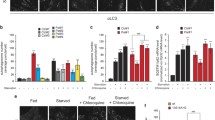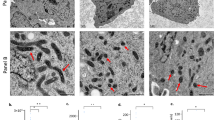Abstract
Mutations in genes affecting mitochondrial proteins are increasingly recognised in patients with epilepsy, but the factors determining cell fate during seizure activity in these mutations remain unknown. Fluorescent dye imaging techniques were applied to fibroblast cell lines from patients suffering from common mitochondrial mutations and to age-matched controls. Using live cell imaging techniques in fibroblasts, we show that fibroblasts with mutations in the mitochondrial genome had reduced mitochondrial membrane potential and NADH pools and higher redox indices, indicative of respiratory chain dysfunction. Increasing concentrations of ferutinin, a Ca2+ ionophore, led to oscillatory Ca2+ signals in fibroblasts resembling dynamic Ca2+ changes that occur during seizure-like activity. Co-monitoring of mitochondrial membrane potential (ΔΨm) changes induced by ferutinin showed accelerated membrane depolarisation and cell collapse in fibroblasts with mutations in the mitochondrial genome when compared to controls. Ca2+ flash photolysis using caged Ca2+ confirmed impaired Ca2+ handling in fibroblasts with mitochondrial mutations. Findings indicate that intracellular Ca2+ levels cannot be compensated during periods of hyperexcitability, leading to Ca2+ overload and subsequent cell death in mitochondrial diseases.







Similar content being viewed by others
Change history
19 May 2018
The original version of this article unfortunately contained mistake. The author’s family name “Kov ac” was written with space thus this should be corrected to “Kovac”.
References
Schapira AHV (2012) Mitochondrial diseases. Lancet 379:1825–1834
Abbott JA, Francklyn CS, Robey-Bond SM (2014) Transfer RNA and human disease. Front Genet 5:158
Goto Y, Nonaka I, Horai S (1990) A mutation in the tRNA(Leu)(UUR) gene associated with the MELAS subgroup of mitochondrial encephalomyopathies. Nature 348:651–653
Shoffner JM, Lott MT, Lezza AM, Seibel P, Ballinger SW, Wallace DC (1990) Myoclonic epilepsy and ragged-red fiber disease (MERRF) is associated with a mitochondrial DNA tRNA(Lys) mutation. Cell 61:931–937
Schapira AHV (2006) Mitochondrial disease. Lancet 368:70–82
Canafoglia L, Franceschetti S, Antozzi C, Carrara F, Farina L, Granata T, Lamantea E, Savoiardo M et al (2001) Epileptic phenotypes associated with mitochondrial disorders. Neurology 56:1340–1346
Kovac S, Domijan A-M, Walker MC, Abramov AY (2012) Prolonged seizure activity impairs mitochondrial bioenergetics and induces cell death. J Cell Sci 125:1796–1806
Kovac S, Domijan A-M, Walker MC, Abramov AY (2014) Seizure activity results in calcium- and mitochondria-independent ROS production via NADPH and xanthine oxidase activation. Cell Death Dis 5:e1442
Williams S, Hamil N, Abramov AY, Walker MC, Kovac S (2015) Status epilepticus results in persistent overproduction of reactive oxygen species, inhibition of which is neuroprotective. Neuroscience 303:160–165
Moudy AM, Handran SD, Goldberg MP, Ruffin N, Karl I, Kranz-Eble P, DeVivo DC, Rothman SM (1995) Abnormal calcium homeostasis and mitochondrial polarization in a human encephalomyopathy. Proc Natl Acad Sci U S A 92:729–733
Trevelyan AJ, Kirby DM, Smulders-Srinivasan TK, Nooteboom M, Acin-Perez R, Enriquez JA, Whittington MA, Lightowlers RN et al (2010) Mitochondrial DNA mutations affect calcium handling in differentiated neurons. Brain 133:787–796
Carafoli E, Lehninger AL (1971) A survey of the interaction of calcium ions with mitochondria from different tissues and species. Biochem J 122:681–690
Szabadkai G, Duchen MR (2008) Mitochondria: the hub of cellular Ca2+ signaling. Physiology (Bethesda) 23:84–94
Denton RM, McCormack JG, Edgell NJ (1980) Role of calcium ions in the regulation of intramitochondrial metabolism. Effects of Na+, Mg2+ and ruthenium red on the Ca2+-stimulated oxidation of oxoglutarate and on pyruvate dehydrogenase activity in intact rat heart mitochondria. Biochem J 190:107–117
Nicholls DG (2005) Mitochondria and calcium signaling. Cell Calcium 38:311–317
Rizzuto R, Pinton P, Carrington W, Fay FS, Fogarty KE, Lifshitz LM, Tuft RA, Pozzan T (1998) Close contacts with the endoplasmic reticulum as determinants of mitochondrial Ca2+ responses. Science 280:1763–1766
DeLorenzo RJ, Sun DA (2006) Basic mechanisms in status epilepticus: role of calcium in neuronal injury and the induction of epileptogenesis. Adv Neurol 97:187–197
Abramov AY, Zamaraeva MV, Hagelgans AI, Azimov RR, Krasilnikov OV (2001) Influence of plant terpenoids on the permeability of mitochondria and lipid bilayers. Biochim Biophys Acta 1512:98–110
Zamaraeva MV, Hagelgans AI, Abramov AY, Ternovsky VI, Merzlyak PG, Tashmukhamedov BA, Saidkhodzjaev AI (1997) Ionophoretic properties of ferutinin. Cell Calcium 22:235–241
Abramov AY, Duchen MR (2003) Actions of ionomycin, 4-BrA23187 and a novel electrogenic Ca2+ ionophore on mitochondria in intact cells. Cell Calcium 33:101–112
Abramov AY, Duchen MR (2010) Impaired mitochondrial bioenergetics determines glutamate-induced delayed calcium deregulation in neurons. Biochim Biophys Acta 1800:297–304
James AM, Wei YH, Pang CY, Murphy MP (1996) Altered mitochondrial function in fibroblasts containing MELAS or MERRF mitochondrial DNA mutations. Biochem J 318:401–407
McKenzie M, Liolitsa D, Akinshina N, Campanella M, Sisodiya S, Hargreaves I, Nirmalananthan N, Sweeney MG et al (2007) Mitochondrial ND5 gene variation associated with encephalomyopathy and mitochondrial ATP consumption. J Biol Chem 282:36845–36852
Appleby RD, Porteous WK, Hughes G, James AM, Shannon D, Wei YH, Murphy MP (1999) Quantitation and origin of the mitochondrial membrane potential in human cells lacking mitochondrial DNA. Eur J Biochem 262:108–116
Mitochondrial Medicine Society’s Committee on Diagnosis, Haas RH, Parikh S, Falk MJ, Saneto RP, Wolf NI, Darin N, Wong L-J et al (2008) The in-depth evaluation of suspected mitochondrial disease. Mol Genet Metab 94:16–37
Invernizzi F, D’Amato I, Jensen PB, Ravaglia S, Zeviani M, Tiranti V (2012) Microscale oxygraphy reveals OXPHOS impairment in MRC mutant cells. Mitochondrion 12:328–335
Rugolo M, Lenaz G (1987) Monitoring of the mitochondrial and plasma membrane potentials in human fibroblasts by tetraphenylphosphonium ion distribution. J Bioenerg Biomembr 19:705–718
Suzuki T, Nagao A, Suzuki T (2011) Human mitochondrial tRNAs: biogenesis, function, structural aspects, and diseases. Annu Rev Genet 45:299–329
Enriquez JA, Chomyn A, Attardi G (1995) MtDNA mutation in MERRF syndrome causes defective aminoacylation of tRNA(Lys) and premature translation termination. Nat Genet 10:47–55
Brini M, Pinton P, King MP, Davidson M, Schon EA, Rizzuto R (1999) A calcium signaling defect in the pathogenesis of a mitochondrial DNA inherited oxidative phosphorylation deficiency. Nat Med 5:951–954
McCormack JG, Halestrap AP, Denton RM (1990) Role of calcium ions in regulation of mammalian intramitochondrial metabolism. Physiol Rev 70:391–425
Ravn K, Wibrand F, Hansen FJ, Horn N, Rosenberg T, Schwartz M (2001) An mtDNA mutation, 14453G→A, in the NADH dehydrogenase subunit 6 associated with severe MELAS syndrome. Eur J Hum Genet 9:805–809
Dunbar DR, Moonie PA, Zeviani M, Holt IJ (1996) Complex I deficiency is associated with 3243G:C mitochondrial DNA in osteosarcoma cell cybrids. Hum Mol Genet 5:123–129
Kirino Y, Yasukawa T, Ohta S, Akira S, Ishihara K, Watanabe K, Suzuki T (2004) Codon-specific translational defect caused by a wobble modification deficiency in mutant tRNA from a human mitochondrial disease. Proc Natl Acad Sci U S A 101:15070–15075
Yasukawa T, Suzuki T, Ishii N, Ohta S, Watanabe K (2001) Wobble modification defect in tRNA disturbs codon-anticodon interaction in a mitochondrial disease. EMBO J 20:4794–4802
Bernardi P, Petronilli V, Di Lisa F, Forte M (2001) A mitochondrial perspective on cell death. Trends Biochem Sci 26:112–117
Sparaco M, Bonilla E, DiMauro S, Powers JM (1993) Neuropathology of mitochondrial encephalomyopathies due to mitochondrial DNA defects. J Neuropathol Exp Neurol 52:1–10
Gurses C, Azakli H, Alptekin A, Cakiris A, Abaci N, Arikan M, Kursun O, Gokyigit A et al (2014) Mitochondrial DNA profiling via genomic analysis in mesial temporal lobe epilepsy patients with hippocampal sclerosis. Gene 538:323–327
Walker MC, Kovac S (2015) Seize the moment that is thine: how should we define seizures? Brain 138:1127–1128
Kovac S, Dinkova Kostova AT, Herrmann AM, Melzer N, Meuth SG, Gorji A (2017) Metabolic and homeostatic changes in seizures and acquired epilepsy-mitochondria, calcium dynamics and reactive oxygen species. Int J Mol Sci 18
Kovac S, Dinkova-Kostova AT, Abramov AY (2016) The role of reactive oxygen species in epilepsy. Reactive Oxygen Species 1:38–52
Kumar MG, Rowley S, Fulton R, Dinday MT, Baraban SC, Patel M (2016) Altered glycolysis and mitochondrial respiration in a zebrafish model of Dravet syndrome. eNeuro 3
Ibhazehiebo K, Gavrilovici C, de la Hoz CL, Ma S-C, Rehak R, Kaushik G, Meza Santoscoy PL, Scott L et al (2018) A novel metabolism-based phenotypic drug discovery platform in zebrafish uncovers HDACs 1 and 3 as a potential combined anti-seizure drug target. Brain 141:744–761. https://doi.org/10.1093/brain/awx364
Brandon MC, Lott MT, Nguyen KC, Spolim S, Navathe SB, Baldi P, Wallace DC (2005) MITOMAP: a human mitochondrial genome database—2004 update. Nucleic Acids Res 33:D611–D613
Kobayashi Y, Momoi MY, Tominaga K, Momoi T, Nihei K, Yanagisawa M, Kagawa Y, Ohta S (1990) A point mutation in the mitochondrial tRNA(Leu)(UUR) gene in MELAS (mitochondrial myopathy, encephalopathy, lactic acidosis and stroke-like episodes). Biochem Biophys Res Commun 173:816–822
Gandhi S, Wood-Kaczmar A, Yao Z, Plun-Favreau H, Deas E, Klupsch K, Downward J, Latchman DS et al (2009) PINK1-associated Parkinson’s disease is caused by neuronal vulnerability to calcium-induced cell death. Mol Cell 33:627–638
Acknowledgements
The authors would like to thank the MRC Centre for Neuromuscular Diseases BioBank London for providing the additional fibroblast lines for this study.
Funding
This work was supported by the Medical Faculty of the University of Münster (17-003 fellowship to SK) and the NIHR Queen Square Dementia Biomedical Research Unit. This work was undertaken at UCLH/UCL which receives a proportion of funding from the Department of Health’s NIHR Biomedical Research Centres funding scheme.
Author information
Authors and Affiliations
Contributions
SK and AYA conceived the study. SK performed and designed the experiments. EP and HH contributed toward the experiments. SK and AYA analysed the data. SK, AYA and MCW wrote the manuscript. All authors critically discussed the data and approved the final version of the manuscript.
Corresponding authors
Additional information
The original version of this article was revised to correct the author's family name “Kov ac” to “Kovac”.
Electronic supplementary material
Supplementary Figure 1
Mitochondrial mass. Bar chart summarizing mitochondrial mass in different fibroblast cell lines. Mitochondrial mass is expressed as mitochondrial volume / total cell volume (%). (GIF 59 kb)
Supplementary Figure 2
Method used to determine MPTP opening in fibroblasts treated with ferutinin. Traces represent mean (± SEM) TMRM fluorescence changes measured over mitochondria (solid triangles) and the nucleus (open triangle). Fluorescence measured over mitochondria show depolarization of ΔΨm in a stepwise fashion. Once a cumulative concentration of 13.5 μM ferutinin is reached, depolarization ΔΨm is accelerated as suggested by the change in the slope of TMRM fluorescence. This change indicates mitochondrial permeability transition pore opening. Due to redistribution of the dye, this appears to coincide with peak TMRM fluorescence in the nucleus. Nuclear peak fluorescence was therefore used to determine MPTP opening. (GIF 216 kb)
Suppl. Table 1
(DOCX 14 kb)
Suppl. Table 2
(DOCX 16 kb)
Rights and permissions
About this article
Cite this article
Kovac, S., Preza, E., Houlden, H. et al. Impaired Bioenergetics in Mutant Mitochondrial DNA Determines Cell Fate During Seizure-Like Activity. Mol Neurobiol 56, 321–334 (2019). https://doi.org/10.1007/s12035-018-1078-9
Received:
Accepted:
Published:
Issue Date:
DOI: https://doi.org/10.1007/s12035-018-1078-9




